
The
Free
Electrons
Pump ( FEP
v1.0)
By Stefan Hartmann and
Jean-Louis Naudin
created on October 28th,
1999 - JLN Labs - Last update November 6th,
1999
Toutes les informations et
schémas sont publiés gratuitement ( freeware ) et sont destinés à un usage
personnel et non commercial
All informations and
diagrams are published freely (freeware) and are intended for a private use and a non commercial use.
This device is based on the Stefan Hartmann's experiment released on
October 26th,
1999 : "The Electron
Pumping FL tube light".

Now, I have reproduced and tested successfully the Hartmann's basic
device and improved the design, so I have built the Free
Electrons
Pump
v1.0 :
The FEP v1.0 is
an enhanced version which uses a spherical capacitor coupled with the earth
atmosphere. As Nikola Tesla had used in the Power Wave experiment in Colorado
springs in June 26, 1899 and also during his tests of the first models of the
Tesla Magnifier
Amplifier tower, the FEP v1.0 uses the same principle for
sucking free electrons from the atmosphere : " To produce
an electrical movement of the required magnitude it is desirable to charge the
terminal as highly as possible, for while a great quantity of electricity may
also be displaced by a large capacity charged to low pressure, there are
disavantages met with in many cases when the former is made too large. The chief
of theses are due to the fact that an increase of the capacity entails a
lowering of the frequency impulses or discharges and diminution of energy of
vibration....." ( Tesla US Patent number 1,119,736 : "Apparatus
for transmitting electrical energy" (issued Dec. 1, 1914) ).

The FEP v1.0 uses a spherical capacitor made with an
aluminum hollow sphere ( 365 mm diam. and 240 mm height ). A 9 Watt neon tube
(OSRAM 9W/Dulux S 41/82) is connected between the FEP generator and the aluminum
sphere.

The FEP generator is a High Voltage Pulses generator which
produces 1380 V pulses at about 29 kHz (see below). The FEP transformer
(L1,L2,L3) is a high frequency transformer (with ferrite core) which can be
found in common portable neon lights (used for camping). But you can also use L1
(7 turns of 4/10mm), L2 ( 6 turns of 5/10 ), L3 ( 750 turns of 1/10 ) wound on a
ferrite core 10mm diam. If you find a ready made ferrite HF transformer, this
will be better.
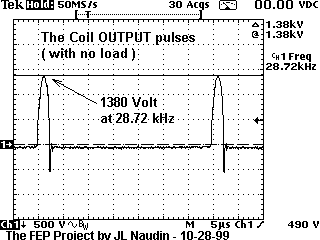
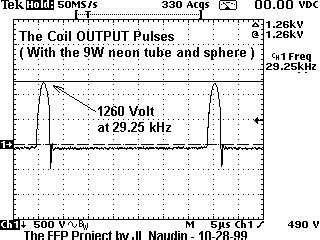
The 9W neon tube is a common low consumption light tube,
but I have removed its original starter circuit.
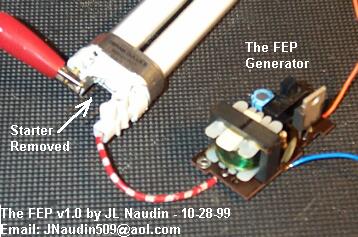

The FEP Generator
MUST BE powered by a battery source ( I
have used a 12V 4 Ah lead acid battery) and MUST NOT BE
GROUNDED. This is very important, because the system MUST
BE OPEN. If you ground the FEP generator circuit, you
build a common closed system and free electrons can't be tapped.
TESTING RESULTS
(10-28-99)

I have used an analog voltmeter
and an analog ammeter, this is strongly recommended for avoiding some parasitic
effects due to the electromagnetic waves induction (EMI) in some digital
equipments which can generate some "false/true"
measurements....
So, when the power is switched
on WITHOUT the neon tube ( with the FEP
output left opened ), the power input required for the functionning of the FEP
circuit is 5.17
Watt (11.5 Volt and 450 mA DC
input )(see below).
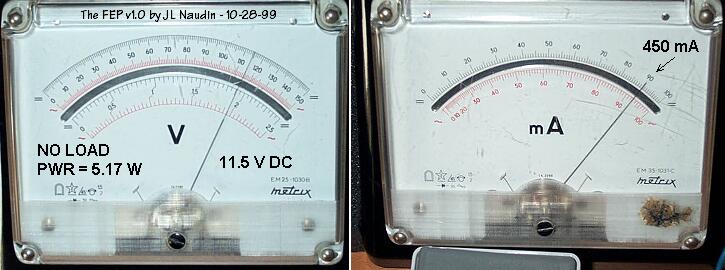
When the 9W neon tube is
connected with its spherical capacitor, the power input DROPS to
4.66
Watt (11.5 Volt and 405 mA DC input ) while the neon
tube throws out about 30% of its max light...(see below)
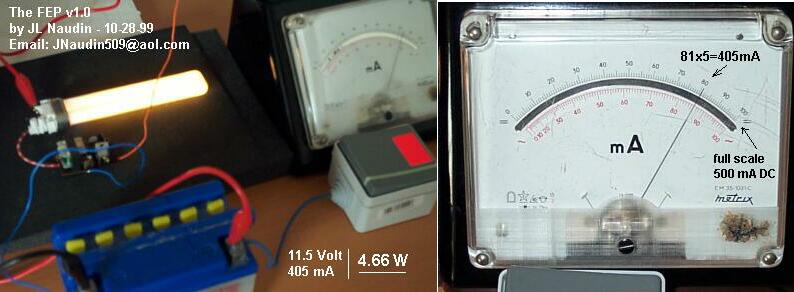

Note : If you don't have an
aluminum spherical capacitor, you may also use a big aluminum sheet as a free
electrons collector.
Now that you have a very simple
electronic circuit that you can build and test by yourself, you will notice that
this circuit works very well and shows that some free electrons can be tapped
easily, from the atmosphere or from the ground with the FEP v1.0
device...
Jean-Louis Naudin October 28th, 1999
POWER I/O Measurements ( JLN 10-29-99)
:
The 9 Watt neon tube has been replaced by a 15
Kohm-5 Watt ( the exact value was 16340 ohm) carbon resistor (see below)
:

I have used a Textronix THS720P isolated and ungrounded
channels oscilloscope for measuring the voltage accross the output resistor. The
RMS and PEAK output voltages has been computerized automaticaly by the
scope.

JLN
Comments:
As you may notice in the diagram
above, the measured output power accross the
resistor was 801 mW RMS for
8.6 Watt Peak, the most interesting thing to observe is that
THE INPUT POWER DROPS of
226 mW while 801 mW is generated at the output.
See
also :
Reference documents
:
1) "The Electrical Experimenter: My Invention by Nikola Tesla",
June 1919
2) Tesla: Man Out of Time, by Margaret Cheney - Prentice-Hall,
Inc
3) Tesla US Patent number 1,119,736 : "Apparatus for transmitting
electrical energy" (issued Dec. 1, 1914)
4) Tesla US Patent number 8,200 : "
Improvements relating to the transmission of Electrical Energy" (17th
Apr.,1906)
5) Theory of Wireless Power, By Eric Dollard, B.S.R.A. 1986.
6)
"Tesla's Tower (Wardenclyffe) by ESJ Staff - Electric Spacecraft Journal, issue
2 (1991)
7) "The Power Wave (1899-1991)" by Ron Kovac - Electric Spacecraft
Journal, issue 3 (1991)
 Email : JNaudin509@aol.com
Email : JNaudin509@aol.com
Return to Tesla
Exploration home
page












